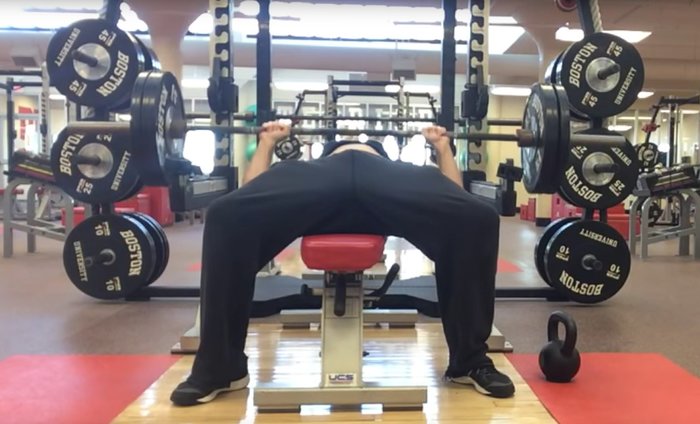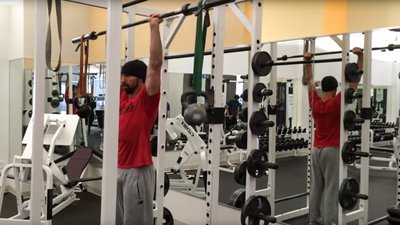If you've ever picked up a VHS off the shelf at Blockbuster—you still do that too, right?—you know that movies often aren't what they appear to be at first glance.
- "The Deer Hunter" isn't about hunting deer.
- "The Neverending Story" actually, you know, ends. There's even a sequel.
- "50 Shades of Grey" is not a coloring book.
Strength training is the same way. Plenty of movements look like a whole lot of weirdness—or a whole lot of nothing—when you see them in a 10-second YouTube clip without context. But with a little more context, they turn out to be just the thing you needed all along to build an epic overhead press or nail that first pull-up.
These three movements are all worthy of being performed without a shred of self-consciousness. Still, it's a good idea to be prepared for the inevitable question: "What is that working?"
HBT Overhead Press
What it looks like: A circus act. Bonus points if you can do it off a BOSU ball while juggling chainsaws.
What it's actually working: Try it, and you'll discover it does plenty. HBT stands for "hanging band training," a concept I learned from Dr. Joel Seedman. You take two resistance bands, fold them in half, hang a light kettlebell from one end, and wrap the other end around a barbell. Then you press, or bench, or squat.
Yes, it looks a bit gimmicky, but HBT does have a fair amount of efficacy and usefulness. The unpredictable and oscillatory characteristics of this form of training provide a unique training stimulus that allows this kind of training to do two things:
- It serves as an excellent assistance exercise to train the shoulders by boosting time under tension. You like time under tension, don't you? Yes, you do.
- It challenges stabilization, increases core demand, and helps "excite" the central nervous system.
Both of these can help you improve your form and move bigger weights on the barbell-and-plate version of the lift.
Key coaching cues to consider: Don't be a hero; you won't need as much weight as your ego thinks you do. The idea is to keep things under control, which is hard to do. Squeeze your glutes, brace your abs, and, as weird as it sounds, press your tongue up against the roof of your mouth, all of which help increase full-body tension. Then press up and down using a tempo of 2-3 seconds up and 2-3 seconds down.
Lying Hollow Position
What it looks like: Not much. I mean, you're just lying there on the ground. What's so hard about that?
What it's actually working: Ohdeargodmycore. I love using this drill with many of my female clients when teaching them the importance of full-body tension, specifically when it comes to doing pull-ups. Building this ability on the ground will translate very well to improved confidence and performance when hanging from a bar. This move is a staple of gymnastics training for a very good reason: It works!
Key coaching cues to consider: Many people's first inclination will be to perform something close to a sit-up, bending at the waist to get into position. This is wrong. The idea here is to "lock" the ribcage to the pelvis and maintain a neutral spine, even (especially) when your body really doesn't want to.
From there, cross your ankles and overlap your hands and press both together...hard. The goal is to work on holding this position for time. For beginners, 10 seconds will be torture because they'll have no concept of what tension really means. I'll then work them up to a total of 30-45 seconds over several "sets."
To up the ante, you can add a PVC pipe or broomstick, and have the client hold it above their head while maintaining the hollow position, then have them emulate the actual movement of a pull-up for several repetitions. It's brutal, but it provides a ton of benefits.
Spoto Press
What it looks like: "Mommy, mommy, what's wrong with that man's bench press? It's missing the bottom two inches!" Everyone knows you're supposed to work every movement through a full range of motion, or you lose Internet cred and the basic protections provided by the constitution.
What it's actually working: Named after world-record raw bench presser Eric Spoto (722 pounds, thank you very much), the Spoto Press is also called the "invisible board press."
The board press, used in varying widths, is a popular bench-press accessory movement used to help trainees work through sticking points in addition to building massive triceps, which play a key role in helping to lock out the bench press.
It's a fantastic exercise and one I use often, but it's far from foolproof. I find many trainees fail to utilize the movement for its intended use and allow the weight to "sink" into the boards, thus dissipating tension.Hopefully, by now, you're catching on to the theme that getting and maintaining tension is a huge key to moving big weights.

"Mommy, mommy, what's wrong with that man's bench press? It's missing the bottom two inches!"
The Spoto Press has several advantages over the traditional board press:
- It forces more time under tension in a range where most trainees typically miss their bench press, 1-2 inches off the chest.
- It teaches you how to maintain tension within that same range of motion.
- It helps to work on bar speed and explosiveness out of a weak ROM.
- It hammers the triceps—ven more so when you train the exercise in a close-grip fashion, as in the video above.
Eric Spoto used these exclusively to bench press 722 pounds, raw. Are you going to be the one to tell him they don't work?
Key coaching cues to consider: I generally like to use this as an accessory movement to the bench pressrather than as a main bench movement. I'll keep loading within 55-70 percent of 1RM and utilize high(er) repetition schemes in the 8-12 range. I'll also vary the pauses from 2-5 seconds. I've seen some coaches go as high as 10 seconds, but I think that's just being mean.
Holding yourself accountable and actually pausing the lift for the allotted time is on you. It helps to perform these with a partner who will keep you honest. It's amazing how a 5-second hold becomes 1.7 seconds when we're left to our own devices.

